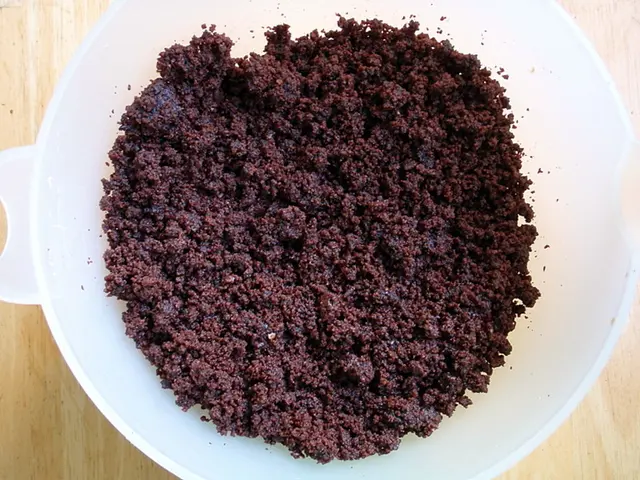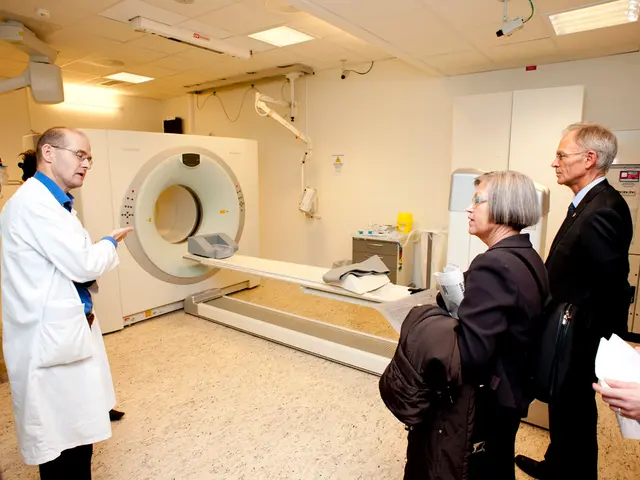Distinguishing age spots from skin cancer: A guide to discernment
Age spots, while often harmless, can sometimes resemble skin cancer. Differentiating between the two is crucial for early detection and treatment. Here's a breakdown of key differences in appearance, symptoms, diagnosis, and treatments.
Distinguishing Characteristics:
- Age Spots: Generally small and flat, these spots are often yellow, brown, or gray and have well-defined borders. Typically, they develop on sun-exposed areas like the face, hands, or shoulders, and tend to increase with age [1].
- Skin Cancer: Skin cancer can take various forms, but melanoma, a dangerous type of skin cancer, is typically irregularly shaped, has an uneven border, displays multiple colors, and is larger in diameter than a pencil eraser [2][3]. It can develop on any part of the body, including areas with minimal sun exposure.
Symptoms:
- Age Spots: Usually, age spots cause no discomfort and are primarily a cosmetic concern.
- Skin Cancer: Symptoms may include changes in size, shape, or color of a mole as well as itching, bleeding, or pain. Sudden changes or new growths should raise concern [2][3].
Diagnosis:
- Age Spots: Diagnosis is usually based on appearance and may not require medical intervention unless the spots change or cause concern.
- Skin Cancer: Diagnosis involves a thorough skin examination using the "ABCDE" criteria: Asymmetry, Border irregularity, Color variation, Diameter, and Evolution. A biopsy may be necessary if a spot is suspicious [2][4].
Treatment:
- Age Spots: Treatment options include cosmetic procedures such as laser therapy, chemical peels, or microdermabrasion to improve appearance [1].
- Skin Cancer: Treatment varies depending on the stage and may include surgical excision, radiation therapy, chemotherapy, or immunotherapy. Early detection is vital for effective treatment [2][3].
In essence, while age spots are generally harmless and cosmetic, skin cancer requires immediate medical attention due to its potential for adverse health consequences if left untreated. Always consult a healthcare professional if you notice any unusual changes to your skin.
[1] "What Are Age Spots?" AARP, aarp.org/health/beauty-fashion/info-09-2019/age-spots.html[2] "Understanding Melanoma: Symptoms, Risk Factors, and Prevention." American Cancer Society, cancer.org/cancer/melanoma-skin-cancer/about/what-is-malignant-melanoma.html[3] "Diagnosing Melanoma." American Cancer Society, cancer.org/cancer/melanoma-skin-cancer/detection-diagnosis-staging/how-diagnosed.html[4] "Signs and Symptoms of Skin Cancer." American Academy of Dermatology, aad.org/public/diseases/skin-cancer/detect/signs-and-symptoms
- Seniors, like others, should be vigilant about skin cancer, especially melanoma, as it can develop on any part of the body, even areas with minimal sun exposure.
- In the field of dermatology, early detection of skin cancer is crucial for effective treatment, requiring regular medical-condition check-ups for health-and-wellness maintenance.
- Age spots, although often harmless and cosmetic, should not be treated lightly, as they can sometimes resemble other skin conditions, including skin cancer.
- Oncology specialists may employ the "ABCDE" criteria for skin cancer diagnosis, checking for symptoms such as an irregular shape, an uneven border, multiple colors, and a larger diameter than a pencil eraser.
- For seniors and others concerned about skin care and skin-conditions, it's essential to prioritize proper skin-care routines and seek medical advice for any unusual skin-condition changes or growths.








